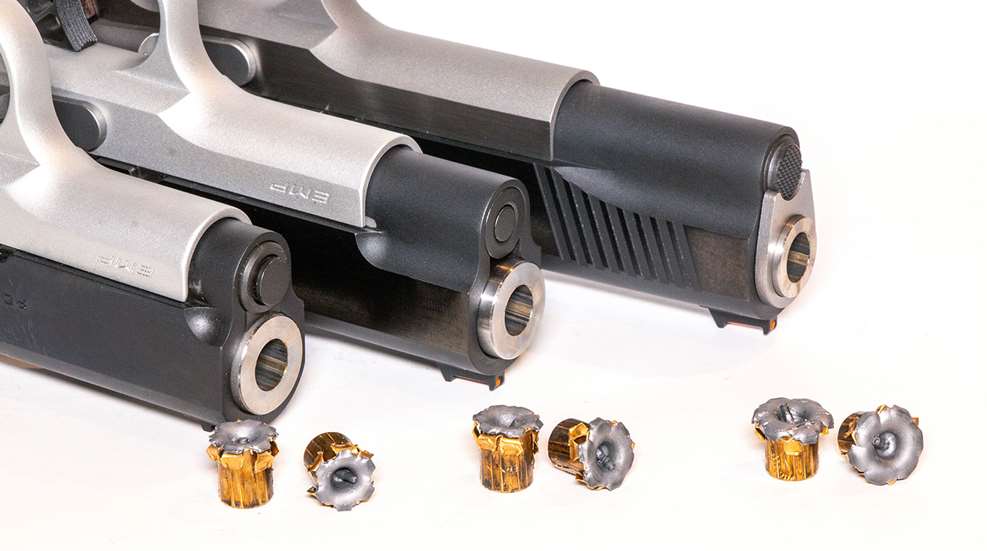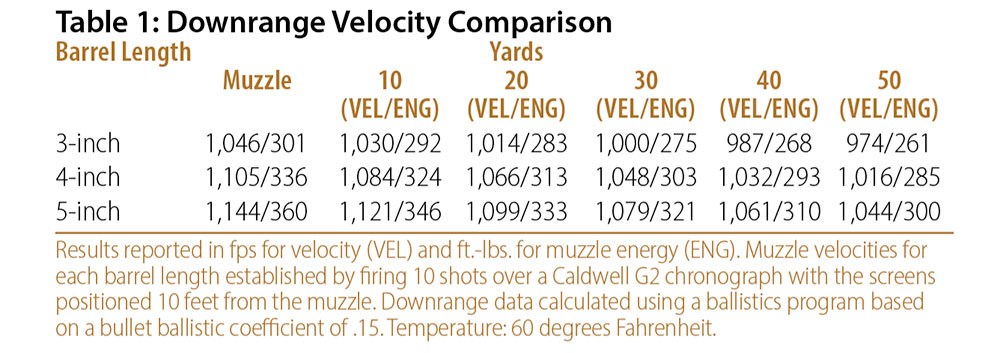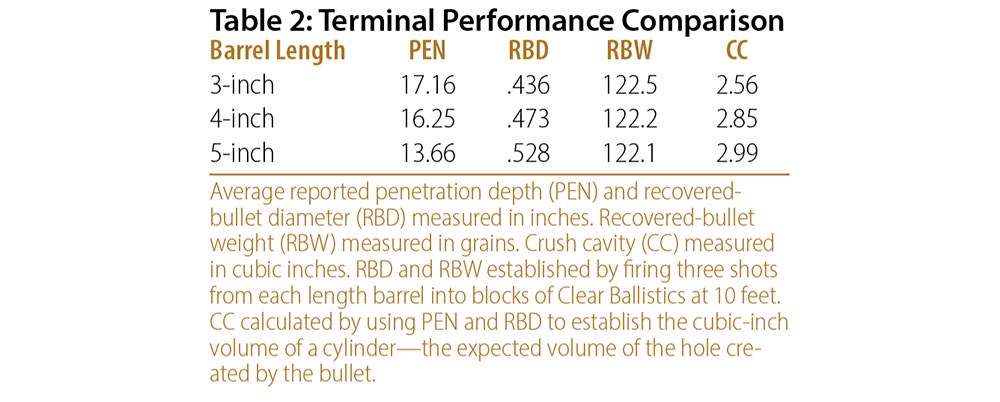
Barrel length—and its impact on terminal performance—needs to be taken into consideration when selecting a self-defense handgun and the ammunition you will carry in it.
Defensive-handgun ammunition is designed and manufactured to deliver an acceptable level of terminal performance over a range of impact velocities. If the bullet impacts with too much velocity, it will lose its integrity and not penetrate to a desirable depth. If the bullet impacts at too slow a velocity, it will not upset at all, damage minimal tissue and penetrate too deeply, maybe even over-penetrating. Most quality self-defense loads are well engineered, but the barrel length from which you shoot them can influence velocity and terminal performance. It’s incumbent upon you to know if your carry load is delivering the type of performance you want from the handgun you’re carrying.
I was recently working with three Springfield Armory 1911s chambered in 9 mm. The purpose of my range work was to determine how detrimental the lighter and shorter-barreled 1911s would be to fast and accurate shooting. For example, Springfield’s 5-inch-barreled Ronin 1911 weighs about 34 percent more than the 3-inch-barreled version. But, during the shooting I became curious about the variance in muzzle velocity between these three pistols and how that might affect terminal performance. There’s no question that a smaller, lighter 1911 is easier to carry, but what if the smaller, lighter 1911 is less terminally effective? Is the trade-off worth it?
The first thing I did was select a respected self-defense load for 9 mm and then chronograph the load out of the 3-, 4- and 5-inch Springfield Ronin 1911s. The load was Federal’s 124-grain Law Enforcement Tactical Hydra-Shok, with an advertised muzzle velocity of 1,120 fps. For a 10-shot string, the average velocity out of the 3-inch gun was 1,046 fps. Out of the 4-inch gun the average velocity was 1,105 fps, which amounted to a 59 fps (5.6 percent) increase in velocity for a 33 percent increase in barrel length. Out of the 5-inch Ronin the load averaged 1,144 fps. This was a 9 percent increase in velocity due to a 66 percent increase in barrel length. On average, the muzzle velocity increased by 49 fps per inch of barrel.
That does not sound like much of a difference at all, given that 49 fps is only 4.4 percent of the advertised muzzle velocity of the load tested. I think most shooters would assume that 50 to 100 fps would not matter that much when it comes to terminal performance. We’ll get to that in a minute, but first let’s look at how velocity changes with distance to the target. Table 1 details the velocity this load had when fired out of each of these guns, from the muzzle out to 50 yards. The main takeaway is that the 5-inch gun will have the same velocity at 50 yards as the 3-inch gun has at the muzzle, and the same velocity at 20 yards as the 4-inch gun has at the muzzle.
When it comes to terminal performance, velocity and energy matter, but the key to how a bullet will upset, penetrate and damage tissue depends on how the bullet is designed and the speed at which it impacts. The common standard for making these comparisons is 10-percent ordnance gelatin as suggested by the FBI. Ideally, the FBI looks for between 12 and 18 inches of penetration with bullet upset equaling about 1.5 times the original bullet diameter. I tested this by firing three shots out of each handgun/barrel length into Clear Ballistics, which is a synthetic ordnance-gelatin approximation. No, the results are never identical, but they are close, and even if they do not exactly represent bullet performance in 10-percent ordnance gelatin, Clear Ballistics does offer a medium for comparison. Table 2 details the results of this test.
What is certain is that when this load is fired from a 3-inch barrel, it will deliver the same terminal performance at the muzzle as it would at 50 yards if it was fired from a 5-inch barrel. Out of a 4-inch barrel and at the muzzle, the load would terminally perform the same as it would out of a 5-inch barrel at 20 yards. While a 50 to 100 fps change in velocity might not seem like much, from a terminal performance standpoint it does make a difference.
As a side note, at the 10-foot testing distance, this load performed decently out of all three barrel lengths, which speaks well to the engineering behind it. Regarding the FBI’s suggested penetration depth, this load met the 12- to 18-inch standard when fired from a 3-, 4- or 5-inch barrel. However, in terms of bullet upset, the only bullets that came close to the suggested 1.5X increase in diameter were those fired from the 5-inch gun.
How all this correlates to a difference in terminal effectiveness we can only guess. Give identical bullet-impact location and path of penetration, the difference is probably minimal. But, in some instances, the deeper penetrating bullet—slower moving—might be the better option. The slower impacting bullet from the 3-inch gun has a penetration advantage of 20 percent. On the other hand, the shallowest-penetrating bullet from the 5-inch gun can create a crush cavity (hole) that is about 17-percent larger. Two things are for certain: As velocity drops, the extent of bullet upset will degrade regardless of barrel length. However, out of the 5-inch gun, bullet upset will never fall below that demonstrated with the 3-inch gun until the range extends beyond 50 yards. Additionally, out of the 3-inch barrel, as bullet upset continues to decrease as the distance to the target increases, penetration will eventually extend beyond that 18-inch recommended depth.
All of this is the reason most ammo manufacturers offer short-barrel loads that have been specifically designed for handguns with shorter barrels. By altering the bullet construction with these loads, they can more closely match the bullet upset and penetration qualities of standard loads when fired from longer barrels. Barrel length is a gun thing, but it does dictate how ammunition will perform. It’s for sure something to keep in mind when selecting your self-defense handgun and defensive ammunition.






































